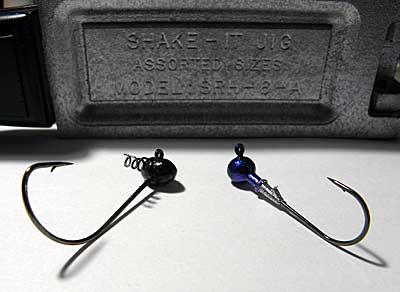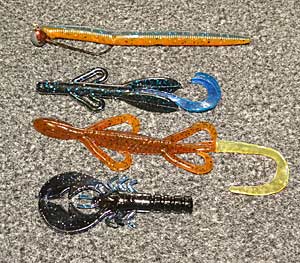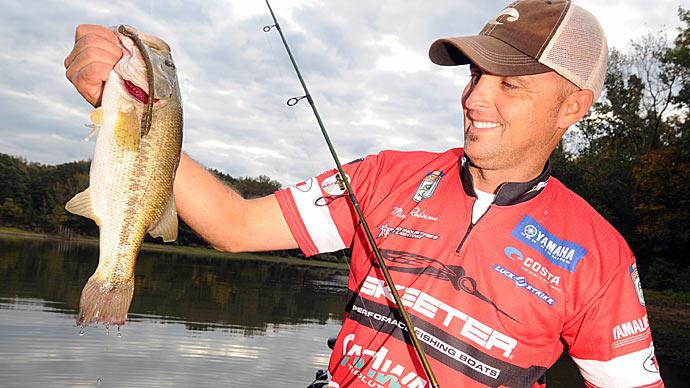
If you want to succeed in bass fishing today, you better have a few different finesse techniques in your tackle box you can turn to and depend on when the bite gets tough. It used to be that you could just put your head down and power fish your way through tough days on the water, but those days are quickly fading away. Today you may have to depend more on finesse fishing to get bass in your tournament bag.
Let’s take a closer look at the Shaky Head technique and how this will help you when the bite gets tough. I have made this one of my finesse tactics for years, and it should be a good tactic for you if you're not using it already.
Let’s go back to April 3, 2009, when BASS pro Jeff Kriet was invited to tape a show called Day on The Water for BASS. This is a show that BASS would invite a touring pro to meet them at a lake location and tape a day on the water to demonstrate how they would break down the lake and catch fish. On that day, Kriet was assigned Lake DeGray in Arkansas.
Early in the day, Jeff started with a jig and a jerkbait looking for bites and signs of bass. Spending the morning looking for his first bite, he decided to pull out a Shaky Head, and the rest is history.
During his afternoon of filming, Jeff could get more than a dozen bass over the side of his boat. Although the Shaky Head Finesse tactic was known in isolated pockets of bass anglers across the country, it was introduced to the bass world a few weeks later when this segment was broadcast during the Saturday morning bass block on ESPN.
Jeff was armed with a 7ft medium-action spinning setup teamed with a spinning reel spooled with a 6lb fluorocarbon line in the early days. He fished two different sized Shaky Jig heads, 1/16oz, and 1/8oz. He said he would fish a 1/8oz jig head 80 percent of the time and follow that up with a 1/16oz jig head 20 present of his time when needed. All along, the only bait that he was putting on these shaky jig heads was a particular worm that was made by Big Bite Baits called the Squirrel Tail. The worm’s name was in homage to Kevin VanDam's nickname for Kriet: “The Squirrel.”
The Squirrel Tail was a 6” worm with a floating tail section. The tail would float up off the bottom and move with the slightest rod movements, triggering strikes when other baits could not. In the early years, the shaky head and the drop shot finesse tactic started to put finesse fishing on the map. These two finesse tactics are still paving the way and are a big part of the finesse package.
Changes In The Shaky Head
So, what has changed through the years when it comes to Shaky Head fishing? Interviewing Jeff a few years back, I posed that exact question to him. He said, “The biggest change that I credit coming to the finesse side of fishing is braided line. In today’s fishing world, braided line is used in many of the techniques they are fishing, and one of the places where it has had the biggest impact is finesse fishing. Many of us have turned to braid when it comes to finesse tactics. I can still throw a 6lb line diameter braided line, but the poundage is 12- to-15lbs now. I have better control over fish and more sensitivity than ever before when using today’s braided line. Braid has been an impact in all of the finesse tactics I use and is now the standard when it comes to line choice in my finesse fishing across the board.”

Another thing that Kriet adds is “finesse baits.” Almost all the plastic bait companies have noticed the finesse movement and have jumped in to produce finesse baits. The finesse segment has grown by leaps and bounds in just a short time and can't be ignored.
Let’s fast forward to today’s Shaky Head tactics as more has changed over the years to help make this tactic a staple in finesse circles.
Let’s break down the fishing line in more detail. Many fishermen have embraced braid as their primary line choice teaming it with a fluorocarbon leader. For me, I pair 12-16lb Sunline Xplasma Asegai braid with an 8lb Sunline FC leader. If I need a little more leader strength or protection, I'll up this to 10lb test.
When faced with tough cold front conditions, bass will tend to drop the bait before you can get a hook into them. I'll change to a straight fluorocarbon line choice when faced with these conditions. The limited stretch that fluoro has built into the line is more than braid offers. Another factor that could be having an effect is the visibility of the braid. Braid is visible under the water even at the smaller diameter it has for its pound test. Although fluorocarbon line is not entirely invisible, it does have reduced visibility under the water.
If the bass senses me and drops the bait before setting the hook, I'll change to a mono leader at the end of my braid. Mono has more stretch and gives me an extra second or two before the fish can feel me. That change is often enough to be effective and gives me a better chance to set the hook. This has been a little finesse secret that I have kept to myself and has been beneficial in helping me put more bass in the boat on days when the bite is super tough.

Shaky Head Jigs
At first, when finesse tactics started to impact the market, there were few jigs available. But that has now changed with the exploding popularity of finesse fishing. Today, multiple jigs are available from a growing list of lure companies.
I like to make my shaky heads from a Do-It Mold, as I have control of the hook size I use in the mold. I also like making either a ball or football jig with a wire keeper to keep my bait locked in place.
Expand Bait Options
In the early days of Shaky Head fishing, the most popular baits were 6” Big Bite Squirrel Tails and 6” straight tail worms. These are still popular today, and you're now seeing some fishermen expand their size by including 8” straight tail worms in their bait selections.
I have also opened my plastics box and used more shapes for finesse baits. With great success, I now use 3”-4” Craws, 4” Tubes, and 4” Lizards and Brush Hawgs in my rotation. Anytime you give the bass a distinctive look, it will pay off with more bites during your day on the water.
When using just a worm, often, I could get one to three bites out of finicky bass. But by offering them different looks from different baits, I have been able to increase bites through the day by just changing baits. Where I was getting one or two bites off a school, I'm now able to get three or more bites when I show them different baits. This alone is a plus as I can increase my bites in the same school instead of looking for new fish after getting a few bites using the same baits.

Beef Up
Yes, I know that the Shaky Head is a finesse technique to trigger bites with light line, but there are times that you can beef up a little and still trigger bites. I'm talking about always carrying baitcasting gear that is on the lighter side of the spectrum. I'm talking a 7ft medium-action rod teamed with a baitcaster reel filled with 20lb Sunline Asegai braid with an 8lb to 10lb fluorocarbon leader, just like on my spinning setup. In cases when I wanted to throw a 1/4oz bait to fight windy conditions, I could fill the void with a baitcaster set up better than I could with a spinning setup.
Another trick that I have been known to do is have a spare baitcaster reel spooled with 10lb to 12lb mono for super tough days when bass are turning their noses up at everything. This has produced bites for me when nothing else will. Any day that you can give the bass, a few different looks are the days that you may be able to get a few more bites, which result in bass in your livewell when everyone else is struggling to get a few bites.
Finesse fishing is here to stay. So pick a couple of tactics that fit how you fish and get to work to adapt and put more fish in your boat. For me, shaky head fishing is working well for my fishing style. Keep an open mind when you create your technique and expand from there. I hope this gets you started in the right direction. One more key: keep experimenting and adapting to find what works in your waters.
BassResource may receive a portion of revenues if you make a purchase using a link above.




